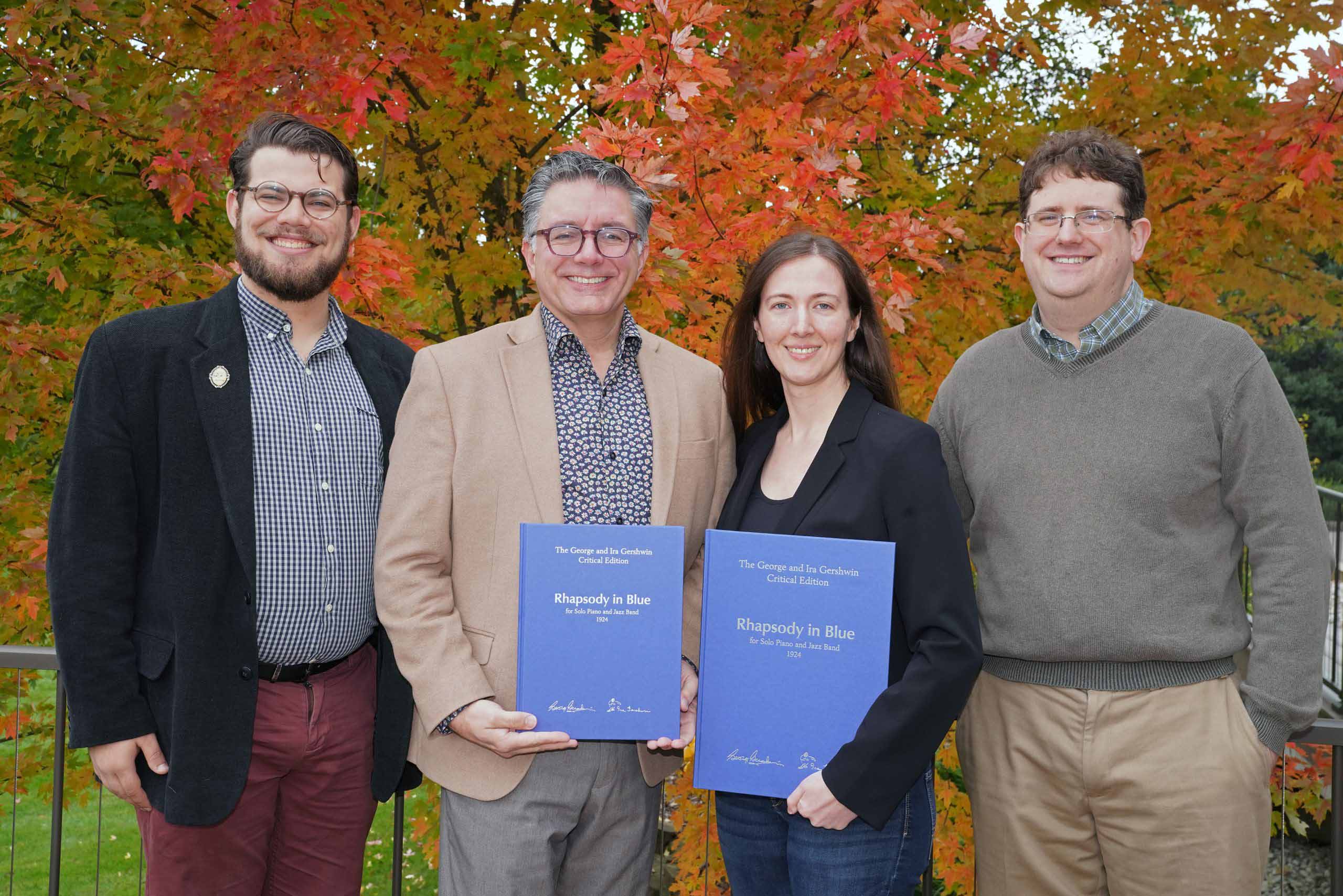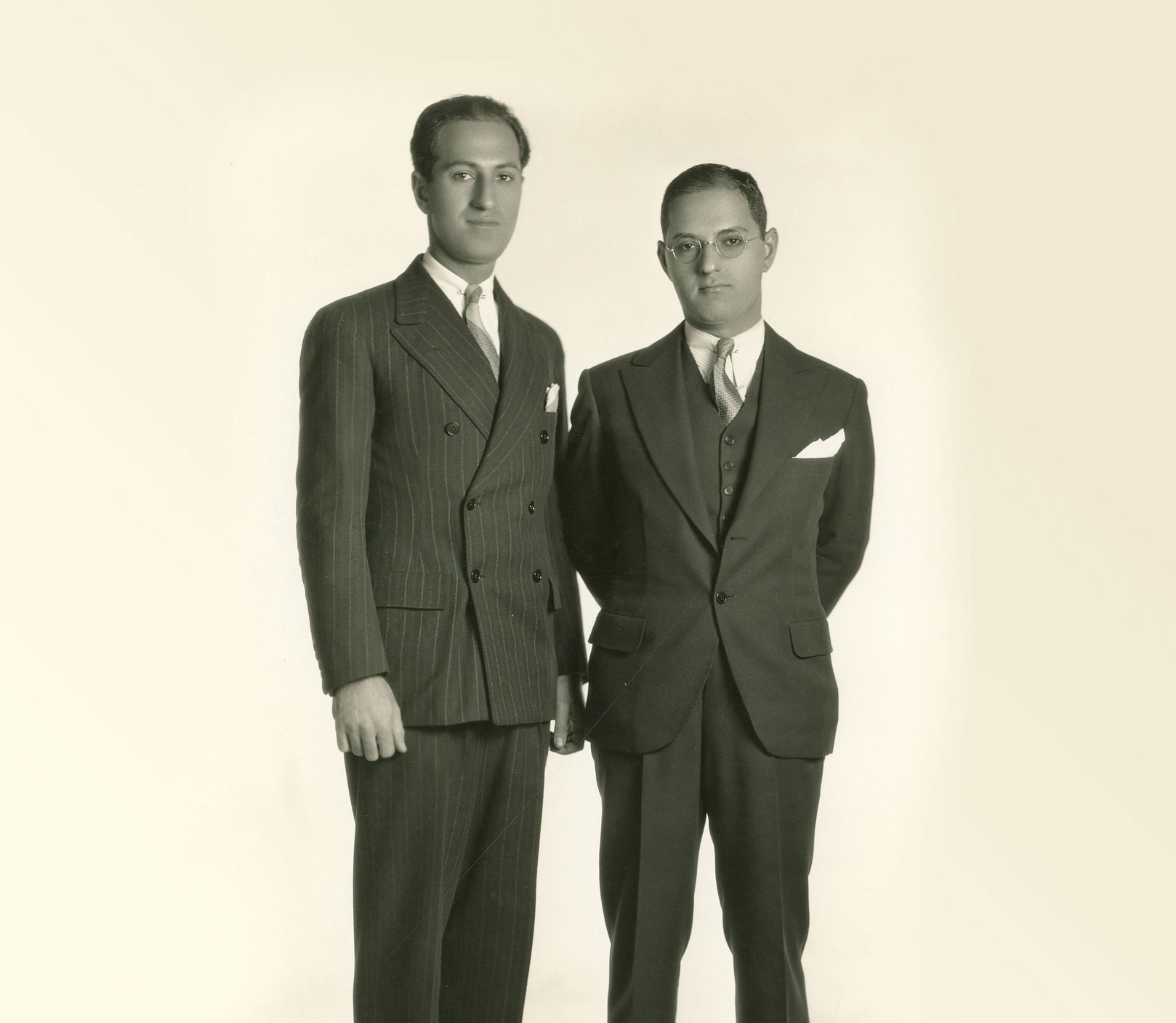About the Gershwin Initiative
Background: The U-M Gershwin Initiative
The University of Michigan Gershwin Initiative is an ongoing scholarly examination of the Gershwins’ music, in which U-M scholars in collaboration with peers from across the nation and globe document and analyze – note-by-note and word-by-word – the treasure trove of works featuring music by George Gershwin (1898–1937) and lyrics by Ira Gershwin (1896–1983) – including Porgy and Bess, often considered America’s greatest opera – as well as the celebrated instrumental works by George Gershwin. The basis for the Gershwin Initiative is a new and complete critical edition to be published in book and electronic forms through European American Music and Schott International. Each volume will contain an introductory essay concentrating on the genesis of the compositions included, as well as critical commentary that explains any editorial decisions made to present the Gershwins’ work. This commentary invites artists to engage more authoritatively with the music as interpreters. The second part of the Initiative includes a variety of courses and musical performances designed to bring the Gershwins’ art to students at the School of Music, Theatre & Dance and, indeed, across campus.
Remarkably, the Gershwins’ works have never received the benefit of scholarly editing, partially due to George Gershwin’s premature and tragic death from a brain tumor at age 38. While readily accessible in print and recordings, the scores and parts to many Gershwin works circulate in substandard editions – often hard-to-read photocopies of handwritten scores – that contain notational errors and confusing inconsistencies. Even such notable scores as Porgy and Bess and Rhapsody in Blue circulate in problematic editions that diminish performances by wasting rehearsal time, at best, and, at worst, causing performance errors.
This substantial and historically significant partnership between the Gershwin families and U-M was initiated by Todd Gershwin, a U-M alumnus who is the grandnephew of George and Ira Gershwin and the son of Marc George Gershwin. The project is overseen by Mark Clague, U-M professor of musicology, who serves as co-editor-in-chief of the George and Ira Gershwin Critical Edition.
This long-overdue scholarship elevates the Gershwins’ work into the pantheon of America’s greatest composers, on library shelves and music stands alongside the music of Stephen Foster and Charles Ives and such canonic European masters as Bach, Beethoven and Brahms.

The Gershwin Initiative has been made possible in part by a major grant from the National Endowment for the Humanities: Exploring the human endeavor.
About the Gershwins
George Gershwin (1898–1937) is one of the world’s most popular and successful composers of the 20th century in any genre – a status that is both compliment and curse. In his too brief but prolific career, George Gershwin composed a long list of popular songs, many written for Broadway and for Hollywood films. He worked with the early 20th century’s top lyricists, though his most brilliant collaborations were with his brother Ira Gershwin (1896–1983), with whom he enjoyed a unique and prolific partnership. Together they have long been honored as two of the leading contributors to the “Great American Songbook.”
George Gershwin created some of music history’s most cherished melodies, not only in song, but also in works for orchestra, such as the jazz-inspired Rhapsody in Blue, and in what is arguably the most significant American opera, Porgy and Bess (with lyrics co-written by Ira Gershwin and DuBose Heyward, on whose book the opera is based).
Ira Gershwin is celebrated for his genius with words, crafting hundreds of lyrics that are clever, funny, moving – or all of the above. Adept at implementing new lyrical styles, playing with timing and incorporating unusual word combinations, he was the first lyricist to be awarded a Pulitzer Prize (in 1932 for Of Thee I Sing).
Ira Gershwin was born as Israel Gershowitz on the Lower East Side of New York City, and George Gershwin was born Jacob Gershwine in Brooklyn, New York. Their Jewish immigrant parents, from St. Petersburg, had joined the American melting pot seeking better opportunity. George took immediately to the piano bought originally for Ira and studied piano with Charles Hambitzer. George later studied composition with Rubin Goldmark and modernist Henry Cowell. George’s skills at the keyboard were admired by African American stride pianists such as Luckey Roberts and James P. Johnson. After George began making a name for himself in the music business, he encouraged Ira to try his hand at writing lyrics. Ira wrote his first song in 1918, launching both his songwriting career and the remarkably successful partnership with his brother.
Perhaps more than any other American composer, George Gershwin integrated a range of musical genres, most notably blending classical music with jazz, blues and popular music phrasings. Influenced by his on-the-job songwriting and performing experience working in New York City’s Tin Pan Alley as a “song-plugger,” George created musical compositions distinguished by their playful and engaging melodies and seemingly spontaneous inflections. He infused popular song with enriched classical harmonies and imbued symphonic and operatic works with the improvisational energy and rhythmic vitality of jazz. His music, according to U-M musicology professor Mark Clague, reflects the power of the American cultural melting pot: A blend of sonic dialects and styles at the heart of democracy.
Because of his tragic and unexpected death due to an untreatable brain tumor, George Gershwin simply did not live long enough to give proper consideration to his musical legacy. Aaron Copland, by contrast, lived to be 90 years old, and his work has been published in accurate and authoritative editions. Following George’s death, Ira continued – after a three-year hiatus – to write lyrics with many talented composers. The George and Ira Gershwin Critical Edition and the U-M Gershwin partnership will at last give the Gershwins’ musical work the editorial attention their artistic stature requires.
The Critical Edition
The Gershwin Critical Edition is the first-ever scholarly edition of the music and lyrics of George and Ira Gershwin. It gives conductors, musicians, performers, scholars and audiences greater insight into the Gershwins’ original material and, in many cases, offers the first performance materials to accurately reflect the creators’ vision. In addition to Porgy and Bess, famous works included in the scholarly review include George Gershwin’s Rhapsody in Blue, An American in Paris, Concerto in F, and Cuban Overture, along with the scores that the brothers wrote together for more than two dozen Broadway and Hollywood musicals, resulting in some of the most recognizable and beloved songs in American music history. Among the dozens of immensely popular songs they crafted together were “I Got Rhythm,” “ ‘S Wonderful,” “Embraceable You,” “Funny Face,” “They Can’t Take That Away From Me,” and “Love is Here to Stay,” just to name a few.
A critical edition combines the best of historical research with the best of editorial accuracy and tradition to produce an edition that represents the authors’ work in as definitive a form as possible. There are critical editions of the plays of Shakespeare, the symphonies of Beethoven, and the poems of E. E. Cummings.
It differs from a standard edition or anthology mainly because the critical edition explains the choices made in its creation. Standard editions present a text but fail to explain the many and inevitable decisions made by editors. With essays, editorial policy statements and explanatory notes, the critical edition invites users to understand the artistry of authors more deeply.
The Gershwins’ music requires careful editing as it combines classical music, jazz, blues and popular song – artistic traditions with very different conventions of musical notation. In an art form like jazz, based on improvisation, notation in transcription is often done after the performance or the playing of the notes. A notated solo by bebop saxophonist Charlie Parker, for instance, would be recognized by his trademark phrases and musical gestures, but it would be the creation of a transcriptionist, rather than the composer. Some of George Gershwin’s most famous works, such as the piano part to Rhapsody in Blue, were only written down after their premiere.
In the case of George Gershwin, who often composed quickly and created versions for a variety of ensembles and contexts, current published editions contain numerous errors of notes and even inconsistencies in the numbers of measures. Scholarship can determine precisely what should be included on the page to best represent the creators’ work.
Our Volumes
These are some of the projected volumes of the George and Ira Gershwin Critical Edition, organized into ten categories. This list is preliminary and not exhaustive. Volumes will be not be released in the order presented here. Volumes currently being negotiated or in process have been marked with an asterisk. The editors have been identified for volumes in production. Names are provided if works are composed or written by someone other than George or Ira Gershwin.

Download the Critical Edition Proposal Guidelines.

Series One - Works for Orchestra
I/1 An American in Paris (1928)* [Mark Clague]
I/2 Cuban Overture (1932)*
I/3 Suite from Porgy and Bess (“Catfish Row,” 1935–36)
Series Two - Works for Piano and Band/Orchestra
II/1 Rhapsody in Blue for Piano and Jazz Band (orch. Ferde Grofé, 1924)* [Ryan Raul Bañagale]
II/2 Rhapsody in Blue for Piano and Orchestra (orch. Ferde Grofé, pub. 1942)* [Jessica Getman]
II/3 Concerto in F for Piano and Orchestra (1925)* [Tim Freeze]
II/4 Second Rhapsody for Piano and Orchestra (1931) [James Wierzbicki]*
II/5 “I Got Rhythm” — Variations for Piano and Orchestra (1934)
Series Three - Piano and Chamber Music
III/1 Lullaby for String Quartet (1919/20)* [Susan Neimoyer]
III/2 Works for Solo Piano
III/3 George Gershwin’s Song Book (1932)* [Andrew Hauze]
Series Four - Operas
IV/1 Blue Monday (1922, libretto and lyr. Buddy DeSylva)
IV/2 Porgy and Bess (1935, George Gershwin, DuBose and Dorothy Heyward, Ira Gershwin)* [Wayne D. Shirley]
Series Five - Stage Shows
V/1 Half Past Eight (1918, lyr. Edward B. Perkins)
V/2 La-La-Lucille! (1919, lyr. Arthur Jackson and Buddy DeSylva)
V/3 Morris Gest’s Midnight Whirl (1919, lyr. John Henry Mears and Buddy DeSylva)
V/4 George White’s Scandals of 1920 (lyr. Arthur Jackson)
V/5 A Dangerous Maid (1921)
V/6 George White’s Scandals of 1921 (lyr. Arthur Jackson)
V/7 Two Little Girls in Blue (1921, comp. Paul Lannin and Vincent Youmans)
V/8 George White’s Scandals of 1922 (lyr. Buddy DeSylva, E. Ray Goetz, and Ira Gershwin)
V/9 Our Nell (1922, comp. George Gershwin and William Daly, lyr. Brian Hooker and A. E. Thomas)
V/10 The Rainbow (1923, lyr. Clifford Grey)
V/11 George White’s Scandals of 1923 (lyr. Buddy DeSylva and E. Ray Goetz)
V/12 Sweet Little Devil (1924, lyr. Buddy DeSylva)
V/13 George White’s Scandals of 1924 (lyr. Buddy DeSylva and Ballard MacDonald)
V/14 Primrose (1924, lyr. Desmond Carter and Ira Gershwin)
V/15 Lady, Be Good (1924)
V/16 Tell Me More (1925, lyr. Ira Gershwin and Buddy DeSylva)* [Bradley Martin]
V/17 Tip-Toes (1925)
V/18 Song of the Flame (1925, comp. George Gershwin and Herbert Stothart, lyr. Otto Harbach and Oscar Hammerstein II)
V/19 Oh, Kay! (1926)
V/20 Strike Up the Band (First Version, 1927)
V/21 Funny Face (1927)
V/22 Rosalie (1928, comp. George Gershwin and Sigmund Romberg, lyr. Ira Gershwin and P.G. Wodehouse)
V/23 Treasure Girl (1928)
V/24 Show Girl (1929, lyr. Ira Gershwin and Gus Kahn)
V/25 Strike Up the Band (Second Version, 1930)
V/26 Girl Crazy (1930) [Ian Sapiro]
V/27 Of Thee I Sing (1931)
V/28 Pardon my English (1933)
V/29 Let ’Em Eat Cake (1933)
V/30 Life Begins at 8:40 (1934, comp. Harold Arlen, lyr. Ira Gershwin and E. Y. Harburg)
V/31 Ziegfeld Follies (1936, comp. Vernon Duke)
V/32 Park Avenue (1946, comp. Arthur Schwartz)
Critical editions of Ira Gershwin’s two stage-show collaborations with Kurt Weill, Lady in the Dark (1941) and The Firebrand of Florence (1945), already have been published by the Kurt Weill Critical Edition.
Series Six - Songs
Series Seven - Film Music
VII/1 Delicious (1931)
VII/2 Shall We Dance (1937)
VII/3 A Damsel in Distress (1937)
VII/4 Cover Girl (1944, comp. Jerome Kern and Henry E. Pether, lyr. Ira Gershwin, E.Y. Harburg, and Fred Leigh)
VII/5 The Barkleys of Broadway (1949, comp. Harry Warren)
VII/6 Give a Girl a Break (1953, comp. Burton Lane)
VII/7 A Star is Born (1954, comp. Harold Arlen)
VII/8 The Country Girl (1954, comp. Harold Arlen)
Series Eight - Textual and Prose Works
VIII/1 The Gershwins Abroad (Ira Gershwin’s 1928 Travel Journal)* [Michael Owen]
Series Nine - Miscellany
Advisory Boards
George and Ira Gershwin Critical Edition
Editorial Board
- Mark Clague, Editor-in-Chief
- Ryan Bañagale
- Jessica Getman
- James Kendrick
- Andrew Kohler, Alfred and Jane Wolin Managing Editor
- Michael Owen
- Loras Schissel
- Karen Schnackenberg
- Wayne Shirley
Collaborating Institutions
- U-M American Music Institute
- Detroit Symphony Orchestra
- European American Music
- Library of Congress
- Schott International
- Society for American Music
Advisory Board
- Marc George Gershwin
- Michael Strunsky
- Adam Gershwin
- Todd Gershwin
- Christopher Kendall
- William Bolcom
- Richard Crawford
- Michael Feinstein
- Walter Frisch
- Thomas Hampson
- Joseph Horowitz
- Laura Jackson
- Andrew Litton
- Joan Morris
- Howard Pollack
- Melody Racine
- Logan Skelton
- Michael Tilson Thomas
- Alfred and Jane Wolin
- Bruce Zenkel
University of Michigan Gershwin Initiative Faculty Advisory Board
Our Team
Staff
Mark Clague, Editor-in-Chief
Andrew S. Kohler, Alfred and Jane Wolin Managing Editor
Jacob Kerzner, Associate Editor
Assistants
Marlina Bowring
Allison Chu
Olivia Davis
Rachel Fernandes
Sophia Janevic
Lisa Keeney
Lena Leson
Joshua Luty
Maria Paterno
Connor Reinman
Brandon Scott Rumsey, DMA
Ellen Sauer
Christopher Sherwood-Gabrielson
Sarah Sisk
Alyssa Wells
Kai West
Previous Team Members
David Belkovski
Timothy Brewer
Matthew Browne, DMA
Sofia Carbonara
Kristen Clough
Matthew Fleischer
Anne Heminger, PhD
Megan Hill, PhD
Jason Paige, DMA
Kathryn Pohl
Carlos Simon, DMA
Frances Sobolak
Sarah Suhadolnik, PhD
Jagienka Timek
Evan Ware, PhD

